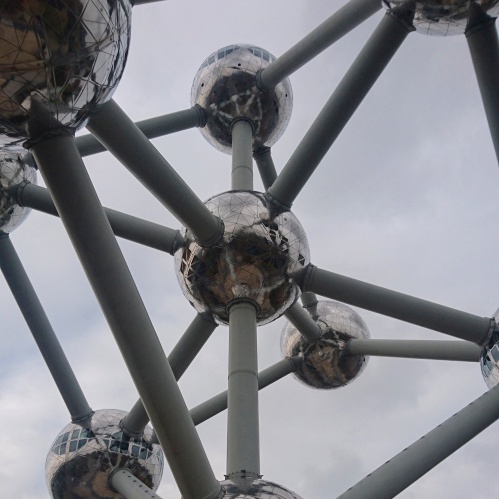During our Brussels trip, we visited a famous landmark and one which surely must appeal to many geeks and nerds like us and must attract them from miles around – The Atomium.

Isn’t that cool? The Atomium is a 102 meter tall model of an iron crystal. Such a crystal would need to be magnified 165 billion times to reach this size. For those who care about materials science (puts up hand, waves it frantically, I do! I do!) iron has a body centred cubic structure, meaning that eight atoms sit at the corners of a cube and a ninth sits at the cube’s centre. This is the smallest number of atoms you need to describe the structure of iron, although you can repeat the pattern ad infinitum if you like.

Crystal lattices like this are really handy ways of describing materials and can tell you a lot about the materials properties. They can also tell you a bit about what to expect when something changes, like if when the crystal is going there’s an atom missing and you get a gap (vacancies), or there’s an atom of something else that doesn’t quite fit (impurities), or for some reason something interrupts the crystal growth and it starts again in a slightly different direction (leading to grain boundaries). I am totally fascinated by all this stuff but I could probably write enough about it to fill a textbook so I’ll shut up here.

However, I’m sure it’s clear why when I heard about The Atomium, I had to go see it. This amazing structure, inspired by materials science, demonstrating fantastic feats of engineering and architecture to provide something that is also art, is just one of the coolest things I’ve seen.
It was built in 1958 for the world expo and was designed by engineer Andre Waterkeyn. The nine spheres are 18 m in diameter and are clad in shiny stainless steel. They’re connected by stainless steel tubes that are 3 m in diameter. Inside the tubes, there are escalators, stairs and an astonishingly fast lift – these connect the five spheres that you can go inside and walk around in.
The Atomium is now a museum. It holds exhibits about the atomic age and the design and construction of The Atomium. There’s a sphere for workshops for kids and there are some pretty psychedelic art installations. There’s a viewing platform at the top sphere, as well as a restaurant (which we sadly didn’t visit because restaurants at the top of landmarks are traditionally extortionately expensive). Apparently, they also do events like film screenings and concerts, which must be one of the most bizarre and wonderful experiences.

From the viewing platform, you can also see Mini Europe. I enjoyed the reflection there, sitting in an iron crystal magnified 165 billion times, looking down at a 1:25th model of Europe. Someone has a sense of humour.
What I thought was most fascinating about The Atomium was the clearly different attitude to science, and especially to atomic physics, from the 1950s. People were looking to science to help build them a better world, which I think it did, but they were also very trusting and optimistic about nuclear power, which surprised me given the events of 1945. Then again, major incidents concerning the generation of nuclear energy wouldn’t arrive for a few decades. Perhaps this only looks strange to me because I’m used to people now being so paranoid about nuclear energy – of course, care is necessary, but fear is not.




